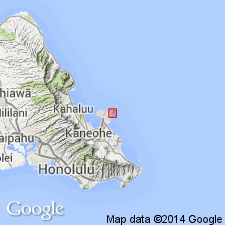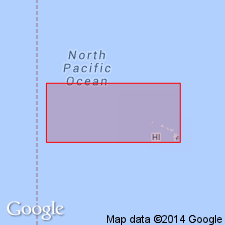
- Usage in publication:
-
- Kii Point limestone
- Modifications:
-
- Named
- Dominant lithology:
-
- Limestone
- AAPG geologic province:
-
- Oahu
Summary:
Named for occurrence at type locality at Kii Point, Ulupau peninsula [21 deg 27' 27"N, 157 deg 43' 34"W, Mokapu 7.5' quad] Island of Oahu. Informally called "oyster bed at Kii Point" by Stearns (1935). Outcrops at 2 small patches on east side of Ulupau peninsula, one at Kii Point and one, 1000 ft to south, and also on northwest side of peninsula. Composed of oyster and barnacle limestone. Is as thick as 30 ft; at sea level is 20 ft. Contains gastropods, pelecypods, and massive corals. At Kii Point grades into calcareous sandstone composed of beach detritus. Overlies eroded surface of Ulupau tuff; underlies "older alluvium".
Source: GNU records (USGS DDS-6; Menlo GNULEX).

- Usage in publication:
-
- Kii Point limestone
- Modifications:
-
- Age modified
- AAPG geologic province:
-
- Oahu
Summary:
Wedge-shaped mass of limestone with maximum thickness of 30 ft, consisting of basal bed 2 to 6 ft thick containing abundant oyster shells and less numerous barnacles, overlain in part by bed 2 to 4 ft thick in which barnacles become very numerous and this in turn overlain by 10 to 28 ft of greenish-yellow calcareous beach sand generally poorly cemented. Locally basal tuff conglomerate is present. Contains: HELCIONISCUS EXARATUS MELANOSTOMA Pilsbury, CHAMA ISOSTOMA Conrad, OSTREA HANLEYANA Sowerby, ANTIGONA RETICULATA (Linnaeus), GLOBICEPHALA sp, and massive corals. Assigned Pleistocene or Recent age.
Source: GNU records (USGS DDS-6; Menlo GNULEX).
For more information, please contact Nancy Stamm, Geologic Names Committee Secretary.
Asterisk (*) indicates published by U.S. Geological Survey authors.
"No current usage" (†) implies that a name has been abandoned or has fallen into disuse. Former usage and, if known, replacement name given in parentheses ( ).
Slash (/) indicates name conflicts with nomenclatural guidelines (CSN, 1933; ACSN, 1961, 1970; NACSN, 1983, 2005, 2021). May be explained within brackets ([ ]).

